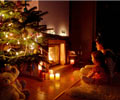In Austria the centuries-old tradition of selling sweet punch, gingerbread and delicate ornaments during Christmas has become a major business operation.
In Austria the centuries-old tradition of selling sweet punch, gingerbread and delicate ornaments during Christmas has become a major business operation.
In Vienna, between three and 3.5 million visitors -- including 500,000 from abroad - are expected at the biggest market: the fairytale-like Wiener Adventzauber in front of the gothic spires of city hall.And it is only one of about 20 major "Christkindlmaerkte" in the capital, with countless private ones strewn across town.
In total, revenues from the markets in Vienna alone will amount to about 60 million euros (90.5 million dollars) this year, according to the local economic chamber (WKW).
"As such, Christmas markets are a significant moneymaker for the Viennese economy," said WKW president Brigitte Jank.
And not just the individual stalls do good business, so does the tourism industry.
"There's an additional 500,000 or 700,000 overnight stays per year thanks to the Christmas markets," estimated Margit Hammerl, Wiener Adventzauber's project manager.
Advertisement
The Tyrolean town of Innsbruck, meanwhile, was due to receive between 800 and 1,000 buses full of Italian tourists over the weekend.
Advertisement
"Until about 25 years ago, there was practically nothing in November in Vienna, the city was dead," Andreas Zenker, a spokesman for the Adventzauber, told AFP.
The city sought a major project to attract tourists after the summer months and the job fell to the Christmas markets, a tradition that appeared as early as 1296 in Vienna and 1491 in Salzburg.
These have become a real "magnet for tourists" in the past two decades, Ulrike Rauch-Keschmann of the National Tourist Office told AFP.
And their success can be seen in the annual tourism figures.
According to the Vienna tourism board, overnight stays in November and December 1986 totalled just over 630,000. Last year, they numbered over 1.6 million, an almost three-fold hike in 23 years.
"It's definitely an economic factor," said Rauch-Keschmann.
The markets are now a key element in any advertising campaign.
Tourists come from neighbouring countries like Hungary, Italy and Germany -- travel agencies organise short shopping trips to Austria that include the Christmas markets -- but also from further afar like the Netherlands, Britain and even Asia.
And the economy at large benefits.
According to the Vienna authorities, the markets and the resulting influx of tourists indirectly create some 30,000 jobs in the hotel and restaurant industry every year.
This year, the city of Vienna and the economic chamber invested some 1.3 million euros in the Wiener Adventzauber, including for publicity, decorations, lighting and children's activities.
"(But) the publicity value is already three times as much as the money invested," thanks to media reports, said Margit Hammerl.
The markets are also still a hit with the locals, who like to meet there over a mug of steaming sweet "Punsch" or "Gluehwein" (mulled wine).
About 1.1 million Viennese - about three quarters of the population -- are expected to visit a Weihnachtsmarkt this year, each giving out an average 18 euros per visit, according to a study by the Vienna economic chamber.
For the stall owners, business is tough. A medium-sized hut at the Adventzauber costs 7,000 euros, applications must be made early, competition is stiff and owners are subject to strict checks regarding their wares and opening hours.
But in the end, it's all worth it, said Rainer Tobisch, who has been selling ceramic dishes and cartoon figurines for over 17 years in different locations.
"Or else we wouldn't keep doing it year after year," he noted.
Source-AFP
RAS














